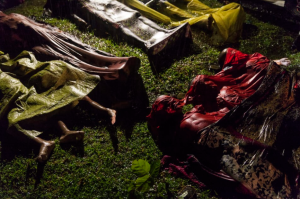This unbearably gruesome photo is the bodies of Rohingya refugees laid out on a beach near Cox’s Bazar, Bangladesh on September 28, 2017. There were only 17 survivors on a boat carrying about 100 people which capsized trying to flee to Bangladesh. The photo is one of the six finalists for the 2017 World Press Photo of the Year award.
It is not possible to speak of forcible repatriation whilst Rohingya continue to cross into Bangladesh fleeing genocide in Arakan/Rakhine state. No decisions can be made about their futures without their direct participation. They are not pawns in some high-stakes geopolitical negotiation. They are a people in the crucibles of genocide.
There is increasing talk of turning Arakan state into an autonomous region so that Rohingya refugees can return safely. There are billions of dollars invested in ‘development’ projects in Arakan, particularly, but not only, the Chinese oil & gas pipelines from offshore wells directly to China. It is highly unlikely, if not absolutely excluded, that China, other countries, & Burma will agree to transfer those assets to the Rohingya people. You cannot have an autonomous territory unless you can control the infrastructures of the economy. But the most compelling reason autonomy is not advisable is that Burma has a high-tech military that will not respect autonomy while the Rohingya people have no military to defend them from genocide by war & other means, including nationalist Buddhist death squads within Arakan state. How would they defend themselves when China, Russia, Israel, India are arming Burma? Who would sell them arms? Would they be forced to become an unarmed military encampment to fend off death squads within Arakan & the Burmese army at the borders? Would autonomy mean they would be safe or that they would be just as unsafe as if they were forcibly deported to the killing fields they fled? That is for the Rohingya people to decide.
(Photo by Patrick Brown for UNICEF)
